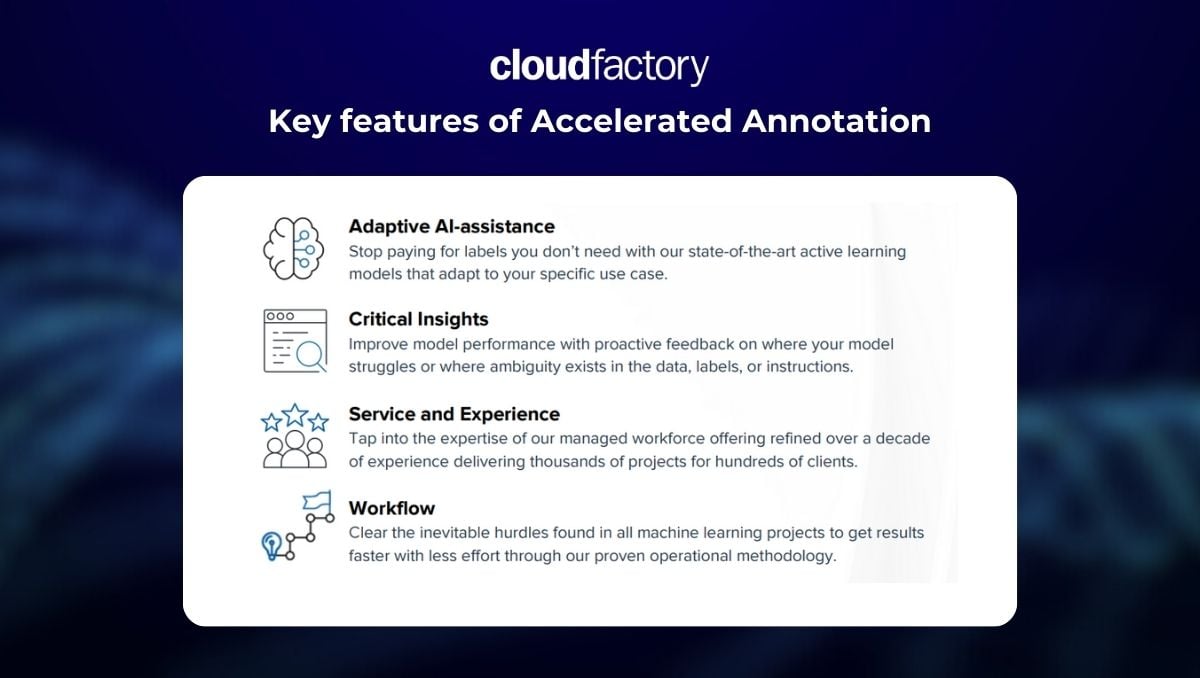Organizations are racing to implement AI and machine learning (ML) into infrastructure asset management decisions.
Transportation departments are using drone-based inspections for bridges; energy companies are employing AI for pipeline monitoring; cities are leveraging ML for predictive maintenance of public infrastructure.
But the only way to develop and deploy models that will successfully perform in the real world is by integrating high-quality data into your infrastructure asset management.
Jump to see how Accelerated Annotation can help your business boost accuracy, performance, and scalability in infrastructure asset health (like crack detection) with AI.
The potential of AI and machine learning in infrastructure asset management
AI and ML are transforming traditional infrastructure asset management methods into intelligent, data-driven processes.
They offer unparalleled opportunities for increased efficiency, reduced costs, and enhanced infrastructure management.
Three ways AI is transforming infrastructure for the better:
- AI-powered infrastructure management practices like asset health and predictive maintenance, for example, can reduce infrastructure downtime and extend asset life, potentially saving millions in maintenance costs.
- Drones equipped with AI for visual inspection can cover areas much faster than manual methods, significantly reducing inspection time and labor costs.
- Real-time data and AI analytics enable faster and more informed decisions, likely leading to increased operational efficiency and reduced costs.
Automated inspection and monitoring
AI-driven systems are capable of continuously monitoring and inspecting infrastructure assets such as bridges, roads, and buildings. These systems utilize advanced sensors, drones, and cameras to collect data, which is then analyzed by ML algorithms to identify signs of wear, corrosion, or other potential issues.
ML models excel in predicting future failures by analyzing historical data. This predictive capability allows organizations to perform maintenance before failures occur, preventing costly downtimes and ensuring the longevity of assets.

AI and ML can process and analyze vast amounts of data far more efficiently than traditional methods. This capability leads to more accurate assessments of asset conditions and better-informed decision-making.
Imagine the following scenario:
Picture a bustling city bridge carrying thousands of commuters daily. Traditional inspection methods might flag minor cracks but fail to detect a hidden, critical structural anomaly. Left unchecked, this could lead to catastrophic failure, endangering lives and immobilizing the city's infrastructure.
Enter AI and ML…
Instead of relying on visual inspections alone, the bridge is equipped with an array of sensors. These sensors continuously collect data on vibrations, temperature, and stress levels throughout the structure. Advanced ML algorithms analyze this data in real-time, drawing on historical records and simulations to identify patterns and anomalies.
The AI predicts with high accuracy that the hidden crack is expanding, posing an imminent risk of failure. This triggers an immediate alert, prompting swift action from infrastructure authorities.
The bridge is closed for necessary repairs before any catastrophe occurs.
The business impact is simple: cost savings, enhanced safety, and improved infrastructure management.
5 Steps to implementing AI and machine learning in infrastructure and asset inspection:
- Align AI and ML technologies with your organization's strategic goals. Whether the aim is to reduce maintenance costs, extend asset lifespan, or enhance safety, the adoption of these technologies should be goal-oriented.
- AI and ML applications rely on high-quality data–usually taking a data-centric approach. Adopting this mindset will yield the highest-performing models.
- Invest in advanced data collection tools. Establish robust data labeling and management practices with a trusted labeling partner.
- Invest in the right talent, training, and data labeling guidelines. Having a team or partner skilled in AI and ML is crucial.
- Consider partnering with an AI data platform provider that can provide access to advanced AI and ML tools, data labeling techniques, AND the expertise to accelerate these technologies.
Let’s see how this technology acceleration happens…
Many companies face the classic dilemma–a reactive versus a proactive approach to infrastructure management.
Traditional methods rely on scheduled inspections, often missing early signs of wear and tear, leading to costly emergency repairs and potential safety risks.
So, imagine a company that embraces AI and ML, aligning with its goal of extending an asset’s lifespan and reducing costs.
They quickly realize that high-quality data is needed to train high-performing models to succeed in the real world. It's not just about data quantity but also quality, accuracy, and relevance.
Partnering with a trusted expert in data annotation is crucial to overcoming data challenges.
After all, an AI model only performs and the quality of data driving it!
How Accelerated Annotation can help
CloudFactory's Accelerated Annotation is the proven winner for business leaders seeking the benefits of integrating high-quality data into infrastructure asset management. If you're looking to improve predictive maintenance, extend equipment life cycles, and make data-driven decisions - adding Accelerated Annotation to your infrastructure AI solutions strategy is a must.
Accelerated Annotation leverages a combination of advanced machine learning algorithms and a skilled human workforce to annotate large datasets with high precision and speed.

The key features of CloudFactory's Accelerated Annotation are adaptive AI-assistance, critical insights, service and experience, and workflow.
If you're ready for more accurate, efficient, and impactful infrastructure asset management models that reduce costs, lower risk, and get into production faster, contact us.
Data Labeling Computer Vision Data Annotation Human in the Loop








